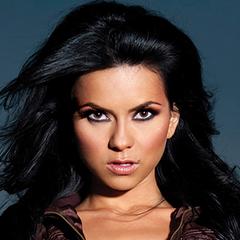歌手:miles davis
2012-12-15、歌谱控、人气:(载入中...)
- 姓名:miles davis
- 性别:男
- 别名:暂无
- 国籍:美国
- 语言:英语;
- 出生地:美国伊利诺州阿尔顿市
- 生日:1926-05-26
- 星座:双子座
- 身高:暂无
- 体重:暂无
miles davis简介:小号手,爵士乐演奏家,作曲家,指挥家,20世纪最有影响力的音乐人之一。
二战以后每一次爵士乐发展运动,戴维斯都站在最前线。他是冷酷爵士乐创始人,也是最早演奏波普爵士乐的爵士音乐家之一。随着爵士乐逐渐被人们所接受,戴维斯的作品的影响力逐渐扩大。台上戴维斯衣冠楚楚,这与早期爵士乐家懒散的装束有着很大的不同。戴维斯的音乐绵软无力,旋律优美。但同时,他又是一个脾气暴躁的人。爵士乐不仅给戴维斯带来了不朽的声誉,同时也给他带来了滚滚财源。他成为了成功音乐人的典范。
大事记
1926年出生的Miles Davis早年去茱利亚音乐学院深造过,但在求学期间就混迹于当地酒吧,并于18岁时录制了首张唱片《First Miles》,1946年,Miles Davis和Gene Ammons合作出了Bebop风格的《Bopping the Blue》,在当时如果你没有Charlie Parker的号召力是很难出头的,Miles Davis在Parker乐队里无法与Parker站在同一高度,为Charlie Parker录唱片的Ross Russell还责怪Miles Davis学习得太慢,但在《Charlie Parker On Dial Vol 4》中,Miles Davis表现出温柔、深思的情绪状态。或许受不了前辈们的轻视,Miles Davis于1947年离开了Charlie Parker,正好逢遇日后也在爵士界举足轻重的编曲家Gil Evans,俩人一谈音乐便很投机,并一起合作了代表一代乐风的Cool专辑《Birth of the Cool》,尽管在这之前钢琴手Lennie Tristano有过类似的尝试。 有一种说法总是贬低Miles Davis:这个人技巧平平,远不及Dizzy Gillespie。可能这是Miles Davis刚入道时的恶劣名声造成的,虽然Miles Davis并非整个爵士乐坛最出色的小号手。但他的思想远远弥补了他的天生弱点,甚至于Davis还创造了一种特殊的表达。听Miles Davis不会觉得只有表面的东西,他太会令你出奇不意了。
在1948年Miles Davis率领的那支九重奏只是一支幕间休息时穿场的乐队,那时的Royal Roost俱乐部是贝西伯爵的天下。九重奏里包括Gerry Mulligan、Lee Konitz、John Lewis、Max Roach这些未来大将。而在这期间,Davis的小号风格更靠近Dizzy Gillespie和Fats Navarro,强调中音区域,音乐更柔和而富有思考性。有意思的是Miles Davis后来还安排Charlie Parker和Sonny Rollins在他的专辑《Collector's Item》中一起演奏。
1951-1954年间,Miles Davis的生活令人捉摸不透,这期间他很少录音,但几乎都是经典,譬如在Blue Note公司录制的《Miles Davis Vol1》和《Miles Davis Vol2》。在五十年代很时尚的乐手中,Gerry Mulligan、Lee Konitz等人皆从Miles Davis那里沐浴到了阳光,那时加州流行Chet Baker闭着眼温柔地演唱“我可笑的情人节”,Miles Davis自然没有这样甜蜜和伤感,他也有点厌烦了乐坛,人都是在不自觉中离自己越来越远,Miles Davis不愿意被人推着走,他要走自己的路。有什么能引起他极大的兴趣呢?在家乡圣路易斯表演吗?继续以全明星的阵容横空出世吗?他的第一批大弟子们一个个都出名成家,他辉煌的第二批弟子们要到60年代才光彩夺目。五十年代对于Miles Davis来说是沉重的,他的健康状况一直不好,不过他几度沉沦又浮起正是从五十年代开始的。一个人一生中能有几次高潮与低潮,下去了还缓得过来吗?但Miles Davis有五次事业高峰,人的精力有限决定了人生在于大多数人只能靠惯性生活,Miles Davis看来是奇迹了
Throughout a professional career lasting 50 years, Miles Davis played the trumpet in a lyrical, introspective, and melodic style, often employing a stemless Harmon mute to make his sound more personal and intimate. But if his approach to his instrument was constant, his approach to jazz was dazzlingly protean. To examine his career is to examine the history of jazz from the mid-40s to the early 90s, since he was in the thick of almost every important innovation and stylistic development in the music during that period, and he often led the way in those changes, both with his own performances and recordings and by choosing sidemen and collaborators who forged new directions. It can even be argued that jazz stopped evolving when Davis wasnt there to push it forward.
Davis was the son of a dental surgeon, Dr. Miles Dewey Davis, Jr., and a music teacher, Cleota Mae (Henry) Davis, and thus grew up in the black middle class of east St. Louis after the family moved there shortly after his birth. He became interested in music during his childhood and by the age of 12 began taking trumpet lessons. While still in high school, he started to get jobs playing in local bars and at 16 was playing gigs out of town on weekends. At 17, he joined Eddie Randles Blue Devils, a territory band based in St. Louis. He enjoyed a personal apotheosis in 1944, just after graduating from high school, when he saw and was allowed to sit in with Billy Eckstines big band, who was playing in St. Louis. The band featured trumpeter Dizzy Gillespie and saxophonist Charlie Parker, the architects of the emerging bebop style of jazz, which was characterized by fast, inventive soloing and dynamic rhythm variations. It is striking that Davis fell so completely under Gillespie and Parkers spell, since his own slower and less flashy style never really compared to theirs. But bebop was the new sound of the day, and the young trumpeter was bound to follow it. He did so by leaving the Midwest to attend the Institute of Musical Art in New York City (renamed Juilliard) in September 1944. Shortly after his arrival in Manhattan, he was playing in clubs with Parker, and by 1945 he had abandoned his academic studies for a full-time career as a jazz musician, initially joining Benny Carters band and making his first recordings as a sideman. He played with Eckstine in 1946-1947 and was a member of Parkers group in 1947-1948, making his recording debut as a leader on a 1947 session that featured Parker, pianist John Lewis, bassist Nelson Boyd, and drummer Max Roach. This was an isolated date, however, and Davis spent most of his time playing and recording behind Parker. But in the summer of 1948, he organized a nine-piece band with an unusual horn section. In addition to himself, it featured an alto saxophone, a baritone saxophone, a trombone, a French horn, and a tuba. This nonet, employing arrangements by Gil Evans and others, played for two weeks at the Royal Roost in New York in September. Earning a contract with Capitol Records, the band went into the studio in January 1949 for the first of three sessions which produced 12 tracks that attracted little attention at first. The bands relaxed sound, however, affected the musicians who played it, among them Kai Winding, Lee Konitz, Gerry Mulligan, John Lewis, J.J. Johnson, and Kenny Clarke, and it had a profound influence on the development of the cool jazz style on the West Coast. In February 1957, Capitol finally issued the tracks together on an LP called Birth of the Cool. Davis, meanwhile, had moved on to co-leading a band with pianist Tadd Dameron in 1949, and the group took him out of the country for an appearance at the Paris Jazz Festival in May. But the trumpeters progress was impeded by an addiction to heroin that plagued him in the early 50s. His performances and recordings became more haphazard, but in January 1951 he began a long series of recordings for the Prestige label that became his main recording outlet for the next several years. He managed to kick his habit by the middle of the decade, and he made a strong impression playing Round Midnight at the Newport Jazz Festival in July 1955, a performance that led the major label Columbia Records to sign him. The prestigious contract allowed him to put together a permanent band, and he organized a quintet featuring saxophonist John Coltrane, pianist Red Garland, bassist Paul Chambers, and drummer Philly Joe Jones who began recording his Columbia debut, Round About Midnight, in October. As it happened, however, he had a remaining five albums on his Prestige contract, and over the next year he was forced to alternate his Columbia sessions with sessions for Prestige to









